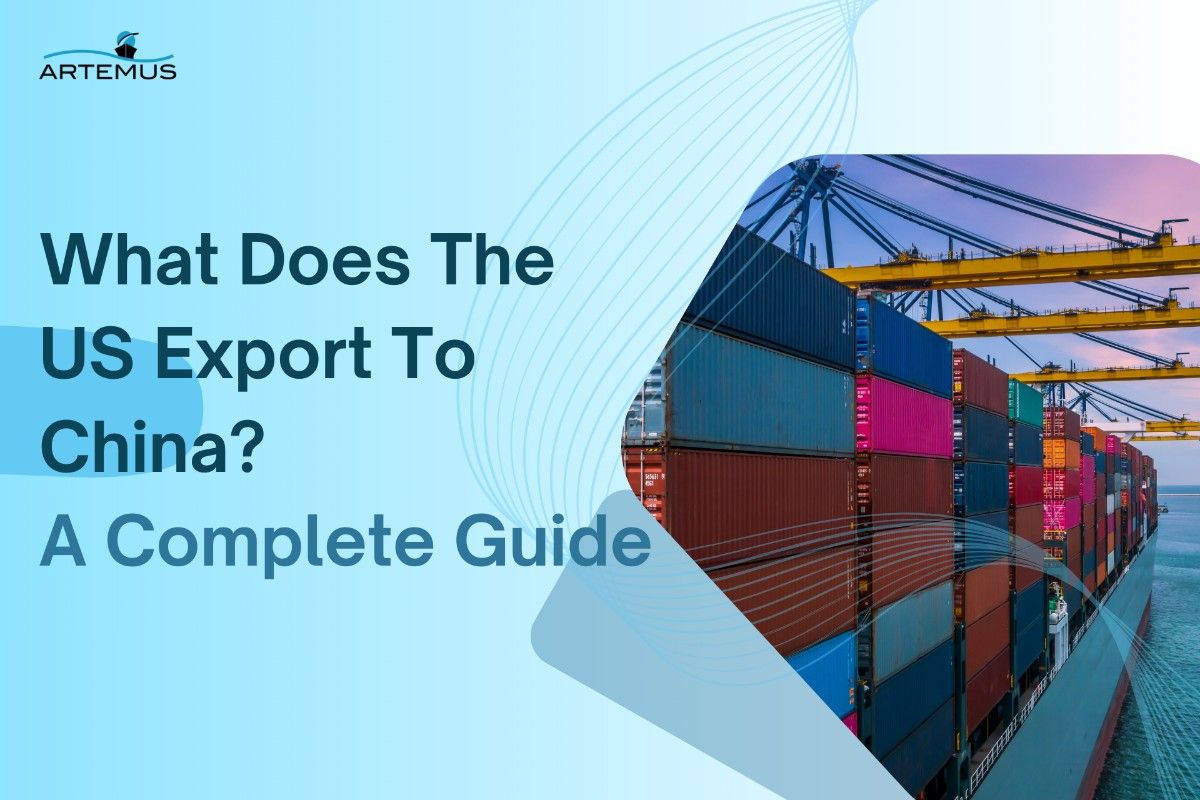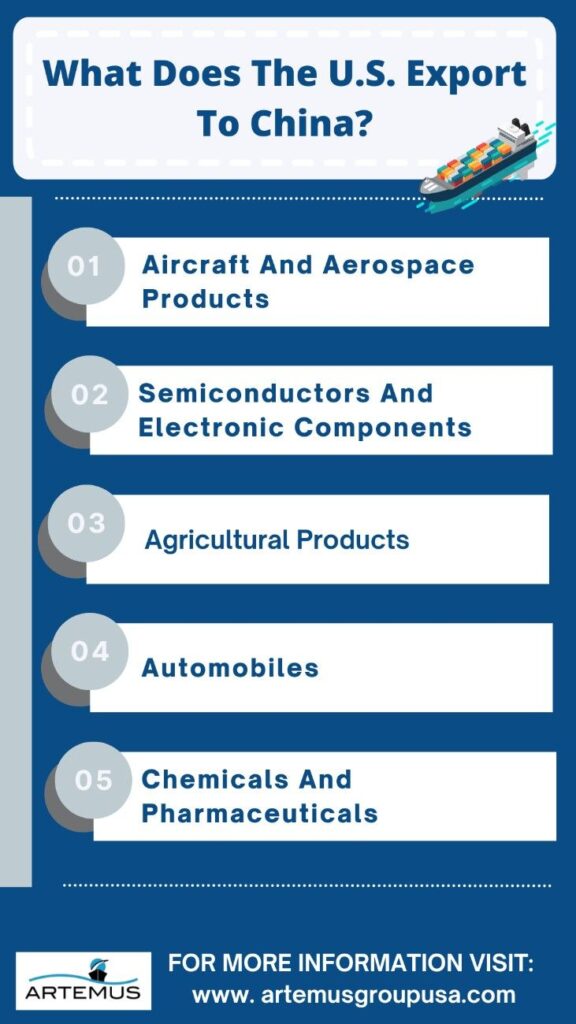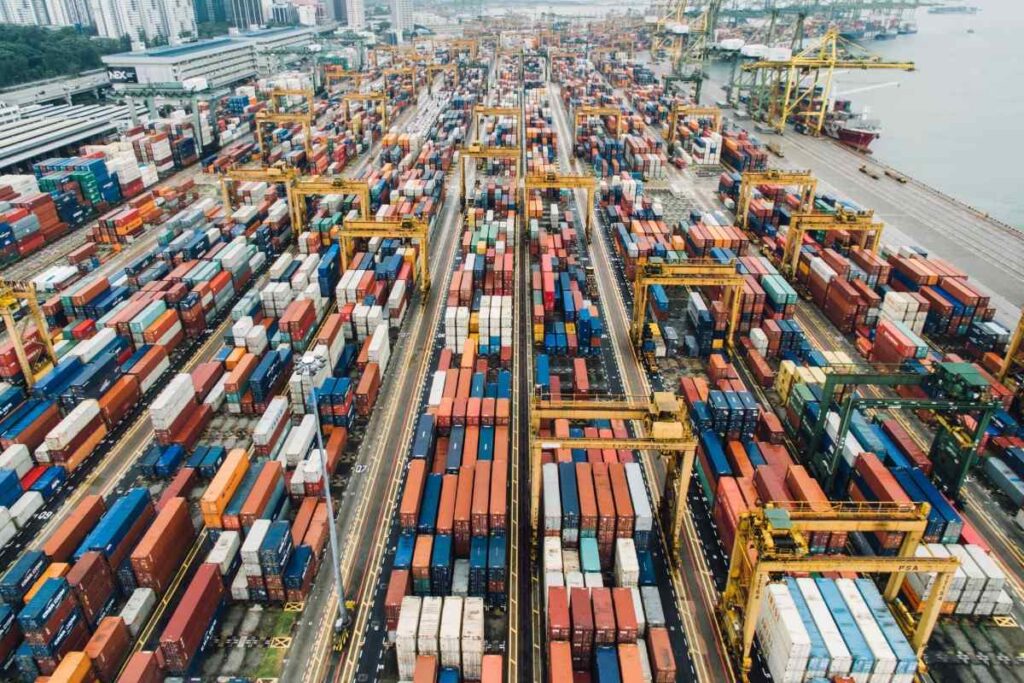
What Is Inbound Logistics & Outbound Logistics? A 2025 Guide
In the dynamic world of supply chain management, understanding the nuances of inbound and outbound logistics is crucial for operational

The United States exports a wide range of products to China, making it one of the largest trading relationships globally. U.S. exports to China reflect diverse market demands from agricultural staples like soybeans and corn to high-tech integrated circuits, energy products, and medical supplies.
This guide explores the top products the U.S. exports to China, the economic value behind these sectors, and the key factors influencing this dynamic trade relationship.
Artemus Transportation Solutions offers ISF, AMS, & AES Filing Software that helps streamline the export process by managing necessary trade documentation, ensuring smooth and compliant transactions for US businesses exporting to China.
Table Of Contents

The United States exports a wide range of goods and services to China, making it one of the U.S.’s largest trading partners. These exports reflect the diverse demands of the Chinese market, ranging from high-tech products to agricultural goods.
One of the leading U.S. exports to China is aircraft and aerospace products. The U.S. is a global leader in aerospace manufacturing, and China is a major importer of commercial aircraft and related parts, as its airline industry continues to expand.
Another significant export category is semiconductors and electronic components. The U.S. is home to some of the world’s largest semiconductor manufacturers, and these products are crucial for China’s growing technology and manufacturing sectors, including consumer electronics, telecommunications, and automotive industries.
The U.S. is a major exporter of agricultural products to China, particularly soybeans, cotton, and meat (such as pork and beef). These agricultural exports play a crucial role in meeting China’s growing food demand and supporting its manufacturing industries.
U.S.-made automobiles, especially high-end models, are also exported to China. The demand for luxury vehicles in China continues to rise, with American brands such as Tesla, General Motors, and Ford contributing significantly to the market.
The U.S. exports a variety of chemicals, including organic chemicals, plastics, and pharmaceuticals, to China. These products are used in numerous industries, including manufacturing, agriculture, and healthcare.
In conclusion, the U.S. exports a mix of high-tech products, industrial goods, and agricultural products to China, reflecting the broad range of needs in the Chinese market.
These exports are vital to the U.S. economy and contribute significantly to the ongoing trade relationship between the two countries.
Related: What Is AMS In Shipping Industry? A Beginner’s Guide
In 2024, the United States played a key role in supplying China with a variety of goods and services, supporting China’s growing technology, energy, and consumer sectors.
Related: What Is Import Compliance & Why It Matters?
The United States exports a variety of agricultural products to China, which is crucial to meeting the country’s growing food demand and supporting its agricultural industries. Some of the key agricultural exports include:
Soybeans are one of the largest agricultural exports from the U.S. to China. China is a major importer of U.S. soybeans, which are primarily used for animal feed and oil production. Soybeans play a key role in supporting China’s livestock and poultry industries.
The U.S. is a major exporter of pork to China, which has a large demand for this protein. U.S. pork exports help meet China’s consumption needs, particularly for processed and fresh pork products.
Corn is another significant export, used both for animal feed and in food products. As China’s demand for animal protein rises, corn serves as a key ingredient in feeding livestock, particularly for the pork and poultry sectors.
The U.S. exports wheat to China for both food production and animal feed. China’s growing demand for wheat is tied to its expanding population and need for diverse food products like noodles, bread, and other grains.
The U.S. is a leading exporter of tree nuts to China, particularly almonds and walnuts. These nuts are increasingly popular in China as snacks and ingredients in various foods.
The U.S. exports a large amount of cotton to China, which is used in textile production. China is one of the world’s largest consumers of cotton, and U.S. cotton is essential to its vast textile industry.
In conclusion, the U.S. exports a wide range of agricultural products to China, including soybeans, pork, corn, wheat, tree nuts, and cotton. These products are vital in supporting China’s growing agricultural and food industries, as well as its demand for diverse food options.
Related: 5 Types Of ISF Penalty & Fines To Know To Avoid Losses
The United States exports a wide range of industrial goods and machinery to China, supporting the country’s growing manufacturing sector and infrastructure development.
These exports are crucial for China’s economic expansion, particularly in industries such as construction, technology, and energy. Some of the key industrial goods and machinery exported include:
The U.S. is a major supplier of high-tech electronic machinery to China, including computers, semiconductors, and telecommunications equipment. These products are vital for China’s rapidly expanding technology and telecommunications sectors.
Industrial machinery, such as equipment for manufacturing, construction, and mining, makes up a significant portion of U.S. exports to China. These machines are used in a variety of industries, helping improve efficiency and productivity in China’s factories and infrastructure projects.
The U.S. exports both commercial aircraft and aerospace components to China. With China’s growing aviation industry, U.S. manufacturers, including Boeing, are key suppliers of aircraft and parts, catering to the increasing demand for air travel in the country.
The export of electrical machinery, including transformers, generators, and electrical components, plays a crucial role in China’s infrastructure development, particularly in the energy and power generation sectors.
U.S. automotive parts and accessories, including engines, transmission components, and other vehicle parts, are important exports to China. These products support China’s expanding automotive industry, both for local production and the growing demand for vehicles.
The U.S. exports a wide range of medical equipment to China, including diagnostic machines, imaging equipment, and surgical instruments. These products are essential for China’s expanding healthcare sector and improving its medical infrastructure.
In conclusion, U.S. industrial goods and machinery exports to China are diverse, ranging from high-tech electronics to industrial machinery and medical equipment. These exports play a crucial role in supporting China’s growing manufacturing, technological, and healthcare sectors.
Related: Late ISF Filing: What To Do If Missed The Deadline?
Technology and electronics play a pivotal role in U.S. exports, making them a significant part of the nation’s trade relationships, particularly with countries like China. The U.S. is a global leader in technological innovation, and its exports of high-tech products help shape industries worldwide.
The major components of this sector include semiconductors, telecommunications equipment, and consumer electronics, among others.
One of the largest and most valuable categories of U.S. technology exports is semiconductors and integrated circuits. These products are crucial for a variety of industries, including consumer electronics, automotive, telecommunications, and industrial machinery.
As the demand for advanced technologies such as 5G, AI, and electric vehicles increases, U.S. exports of semiconductors continue to grow in global markets.
U.S. exports of telecommunications equipment, such as networking hardware, wireless communication devices, and routers, are essential in supporting global connectivity. With the rapid development of 5G networks and the increasing need for data infrastructure, U.S. companies remain key suppliers of advanced telecommunications technology.
The U.S. is a leading exporter of consumer electronics, including computers, smartphones, tablets, and other electronic devices. These products are in high demand globally, particularly in markets like China, Europe, and other parts of Asia. U.S. brands like Apple, Microsoft, and Intel are major players in the global electronics market.
Medical technology and devices are another critical area of U.S. technology exports. The U.S. exports a wide range of products, including diagnostic equipment, imaging systems, and therapeutic devices. These high-tech medical tools are in demand worldwide, especially as healthcare systems around the globe modernize and expand.
The export of software and IT services also plays a key role in U.S. trade. Cloud computing, cybersecurity solutions, enterprise software, and digital services are areas where U.S. companies have a global competitive advantage. These services are vital for businesses around the world to enhance productivity, improve security, and manage complex data systems.
In conclusion, technology and electronics are central to U.S. exports, with key sectors such as semiconductors, telecommunications, and consumer electronics driving trade with countries across the globe.As technology continues to advance, U.S. exports in these areas are expected to play an increasingly important role in the global economy.
Related: AMS Fee In Shipping: Overview & 5 Key Considerations
Energy products have become a significant export category from the U.S. to China, driven by China’s growing energy needs and its efforts to diversify its energy sources.
As the world’s largest energy consumer, China is increasingly relying on imports to meet its energy demands, and the U.S. plays a key role in supplying essential energy products.
One of the fastest-growing energy exports from the U.S. to China is liquefied natural gas (LNG). As China seeks to reduce its reliance on coal and address air pollution, LNG offers a cleaner alternative for power generation and industrial use. U.S. LNG exports are expected to continue to grow as China’s demand for cleaner energy increases.
The U.S. exports significant amounts of crude oil and refined petroleum products to China. These products are vital for China’s energy needs, supporting its vast industrial base, transportation sector, and growing demand for consumer goods. As China works to meet its energy goals, U.S. petroleum exports remain an essential part of the supply chain.
Though China is shifting toward cleaner energy, it still imports substantial amounts of coal, and the U.S. is one of its key suppliers. U.S. coal exports support China’s energy production and industrial processes, particularly in power plants and steel manufacturing.
In conclusion, energy products like LNG, petroleum, and coal are increasingly important exports from the U.S. to China. As China’s energy needs continue to rise, the demand for U.S. energy exports is expected to grow, reinforcing the trade relationship between the two nations.
Related: AMS Filing Penalty Cost: Most Common Pitfalls & Solutions
Trade between the U.S. and China has been a cornerstone of the global economy, but it has also faced several challenges. These challenges are rooted in trade imbalances, intellectual property issues, and geopolitical tensions, which impact both countries’ economic relations.
One of the main challenges in U.S.-China trade is the significant trade deficit the U.S. has with China. The U.S. imports far more from China than it exports, which has led to concerns about the sustainability of this imbalance. The deficit often leads to political tensions and calls for tariff impositions and trade restrictions as a way to reduce the gap.
Intellectual property (IP) rights have been a major source of friction between the two nations. The U.S. has raised concerns that China has not adequately protected American patents, trademarks, and other intellectual properties, with accusations of forced technology transfers.
These issues have been central to trade negotiations and have resulted in tariffs and sanctions.
The imposition of tariffs has been a significant trade challenge, particularly during the U.S.-China trade war that began in 2018. Both countries imposed high tariffs on each other’s goods, leading to disruptions in trade and increased costs for businesses and consumers.
Although there have been attempts to negotiate and resolve tariff issues, trade barriers remain a persistent problem.
Geopolitical tensions, particularly over issues such as Taiwan, Hong Kong, and the South China Sea, have influenced U.S.-China trade relations. Diplomatic disputes can impact trade agreements, causing uncertainty in business operations and international trade.
In conclusion, U.S.-China trade faces several ongoing challenges, including trade imbalances, intellectual property concerns, tariffs, and geopolitical tensions. These issues continue to shape the economic relationship between the two largest economies in the world.
Related: Merchandise Processing Fee (MPF): A Complete Guide
Trade policies play a significant role in shaping U.S. exports, influencing everything from tariffs to trade agreements and regulations. These policies determine the flow of goods and services between the U.S. and its trading partners, affecting businesses, consumers, and the overall economy.
Tariffs and trade barriers can either promote or hinder U.S. exports. When foreign governments impose high tariffs on U.S. goods, it increases the cost for foreign consumers, potentially reducing demand.
Conversely, U.S. tariffs on imports can encourage domestic production and protect local industries, but they can also lead to retaliation from trading partners, impacting U.S. exports.
Trade agreements, such as the United States-Mexico-Canada Agreement (USMCA) or agreements with other nations, open up new markets for U.S. exports. These agreements reduce trade barriers, lower tariffs, and provide U.S. businesses with more favorable terms for accessing international markets.
Trade deals can significantly boost export volumes, as they facilitate smoother trade flows and expand market access.
Government policies that offer export subsidies, incentives, or financial support to U.S. exporters can enhance competitiveness in global markets. Programs like the Export-Import Bank of the United States (EXIM Bank) help U.S. businesses secure financing, especially in emerging markets.
These policies help U.S. exporters compete by reducing financial risks and improving their market presence.
Trade policies also encompass regulatory standards for U.S. exports, including safety, environmental, and labor regulations. Strict compliance requirements can sometimes create barriers for U.S. products in foreign markets.
However, in regions where U.S. standards are viewed as higher, these regulations can help U.S. exports stand out as premium products, boosting their appeal.
In conclusion, U.S. trade policies have a profound impact on exports, influencing tariffs, trade agreements, financial support, and regulatory compliance. These policies can either facilitate or hinder U.S. companies’ ability to compete in international markets.
Related: ISF Filing Requirements: A Step-By-Step Guide
The future of U.S. exports to China is influenced by several factors, including technological advancements, environmental goals, and trade policies. Key sectors are expected to see growth as both countries adapt to changing economic landscapes.
China’s growing demand for advanced technology, such as semiconductors and AI, will drive increased U.S. exports in these sectors. These products will be crucial for China’s digital infrastructure and innovation.
As China focuses on carbon neutrality, U.S. clean energy products like solar panels and electric vehicle components are expected to see higher demand. U.S. companies are well-positioned to contribute to China’s green energy transition.
U.S. agricultural exports, particularly soybeans, pork, and grains, will continue to grow as China seeks to diversify its food sources to meet the needs of its expanding middle class.
With an aging population and expanding healthcare infrastructure, China’s demand for U.S. medical devices, pharmaceuticals, and healthcare technology is set to rise in the coming years.
Changes in trade policies, including potential tariff reductions and new trade agreements, will influence U.S.-China trade flows. Both nations will need to navigate economic and political factors to maintain a favorable trading relationship.
In conclusion, U.S. exports to China will continue to grow, especially in high-tech, clean energy, agriculture, and healthcare sectors, as both countries adapt to evolving economic and geopolitical conditions.
Related: Which Party Issues The Export Declaration Document?
Artemus offers efficient filing software for managing ISF, AMS, and AES requirements in U.S.-China trade. It simplifies compliance with U.S. Customs regulations, helping businesses avoid delays and costly penalties.
For U.S. imports, Artemus handles ISF and AMS filings quickly, ensuring timely data submission to Customs. This automation minimizes errors and streamlines logistics, enhancing cargo movement efficiency.
On the export side, Artemus supports accurate AES filing for shipments to China, integrating with carriers for smooth document sharing. Artemus is a reliable tool for simplifying complex trade filings.
The main US exports to China include soybeans, aircraft, machinery, electrical machinery, and chemicals.
China imports soybeans, machinery, electrical machinery, aircraft, and agricultural products from the US.
America’s biggest export is machinery, followed by electrical machinery, vehicles, and mineral fuels.
The US exports the most soybeans to China, followed by automobiles, aircraft, and machinery.
China’s biggest trading partner is the United States, followed by Hong Kong and Japan.
Canada’s #1 export is crude oil, followed by automobiles, gold, and other natural resources.
China relies on the US for advanced technology, machinery, and agricultural products like soybeans and cotton.
The US exports machinery, vehicles, aircraft, electrical machinery, and optical instruments to Japan.
The United States has the highest trade deficit, primarily with countries like China and Mexico.
The UK’s biggest exports are machinery, vehicles, and pharmaceuticals, followed by financial services.
China is the #1 exporter to the US, followed by Mexico and Germany.
Yes, the US imports toilet paper, although it also produces a large portion of its supply domestically.

In conclusion, global trade plays a significant role in shaping the economies of nations. The flow of goods between countries, such as the US, China, and Japan, highlights the interconnectedness of global markets. Key exports and imports, ranging from machinery to agricultural products, influence job markets and innovation.
Nations rely on each other for resources and products that drive their economies forward. By understanding major exports and imports, businesses can better navigate the complexities of international trade, contributing to growth and stability.
Ultimately, international trade fosters economic partnerships, creating opportunities for countries to thrive together. As markets evolve, the importance of trade in shaping the future of commerce cannot be overstated.
Related: Shipping From China To USA: All You Need To Know In 2024

In the dynamic world of supply chain management, understanding the nuances of inbound and outbound logistics is crucial for operational

In today’s interconnected world, businesses rely heavily on global trade to expand their markets, access new resources, and drive growth.

Importing goods for resale in the USA presents a lucrative business opportunity, but navigating the complexities of U.S. customs regulations,
Get In Touch
Artemus’ Software Solutions for ISF, AMS, Japan AFR, eManifest Canada, & Panama B2B filings.